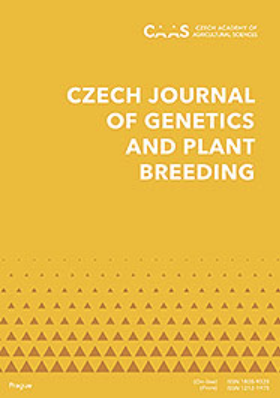孟加拉国水稻品种形态-分子多样性研究
IF 1.8
4区 农林科学
Q3 AGRONOMY
引用次数: 3
摘要
水稻是世界上最重要的谷物之一,也是孟加拉国的主要种植作物。共使用11个简单重复序列(SSRs)和13个序列标记位点(STS)标记对孟加拉国24个水稻品种进行了鉴定。24个标记产生60个等位基因,每个位点2.5个等位基因。多态性信息含量(PIC)均值为0.40,杂合度均值为0.10,基因多样性均值为0.48,主等位基因频率均值为0.62。然而,SSR标记比STS标记具有更强的特异性和更强的识别能力。聚类分析显示4个主要聚类,遗传相似系数为0.73。籽粒形态分析结果表明,Binadhan-20和BRRI - dhan34籽粒尺寸最长、最短,籽粒长度、籽粒宽度和籽粒长宽比呈变量相关。苯酚反应试验鉴定出7个品种为粳稻,17个品种为籼型或中间型。这些表型数据和标记信息将为现代水稻育种中的亲本选择提供参考。本文章由计算机程序翻译,如有差异,请以英文原文为准。
Morpho-molecular diversity study of rice cultivars in Bangladesh
Rice is one of the frontline cereals in the world and the major cultivated crop in Bangladesh. A total of eleven simple sequence repeats (SSRs) and thirteen sequence-tagged site (STS) markers were used to characterize twenty-four rice cultivars in Bangladesh. Twenty-four markers generated 60 alleles with 2.5 alleles per locus. The average polymorphism information content (PIC) value was 0.40, while the mean value of heterozygosity, gene diversity, and major allele frequency were recorded as 0.10, 0.48 and 0.62, respectively. However, the SSR markers showed more specificity and a higher discrimination power than the STS markers. The cluster analysis displayed four major clusters with a genetic similarity coefficient value of 0.73. The morphological analyses of the grain identified that Binadhan-20 and BRRI dhan34 had the longest and the shortest seed size, respectively, with a variable correlation between the seed length, width and length/width ratio. The phenol reaction test distinguished seven cultivars as japonica and seventeen cultivars as indica or an intermediate type. All these results regarding the phenotypic data and marker information will be useful for parental selection in modern rice breeding programmes.
求助全文
通过发布文献求助,成功后即可免费获取论文全文。
去求助
来源期刊

Czech Journal of Genetics and Plant Breeding
Agricultural and Biological Sciences-Plant Science
CiteScore
2.20
自引率
0.00%
发文量
25
审稿时长
>12 weeks
期刊介绍:
Original scientific papers, critical reviews articles and short communications from the field of theoretical and applied plant genetics, plant biotechnology and plant breeding. Papers are published in English.
 求助内容:
求助内容: 应助结果提醒方式:
应助结果提醒方式:


